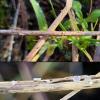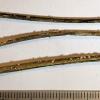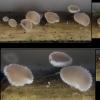
04-11-2025 09:07
Hello.A suspected Hymenoscyphus sprouting on a thi

04-11-2025 12:43
 Edvin Johannesen
Edvin Johannesen
Hi! One more found on old Populus tremula log in O

03-11-2025 21:34
 Edvin Johannesen
Edvin Johannesen
These tiny (0.4-0.5 mm diam.), whitish, short-stip

28-10-2025 15:37
Carl FarmerI'd be grateful for any suggestions for this strik

03-11-2025 16:30
 Hans-Otto Baral
Hans-Otto Baral
Hello I want to ask you if you have found this ye

28-10-2025 19:33
 Nicolas Suberbielle
Nicolas Suberbielle
Bonjour à tous,Je voudrais votre avis sur cette r

31-10-2025 09:19
 Lothar Krieglsteiner
Lothar Krieglsteiner
Can somebody provide me with a file of:Rogerson CT
Lachnum tenuipilosum on Ammophila arenariain
B Shelbourne,
29-11-2024 17:51
• Using Baral's key, subkey 3: No crystals, VBs, croziers, hair apices uninflated.
• Of these species on grasses, L. tenuipilosum seems to be the best fit.
• Some characters fit better with L. 'longipilosum' in the key, but perhaps these have been combined now.
Habitat: Apparently widespread (micro only on one collection) on dead stems and sheaths of Ammophila arenariain, standing or fallen, both on the inside and outside of the sheaths, in damp places under cover of living plants, on sand dunes, both sides (sea and land), on a beach, river mouth nearby, West Beach, Angmering, south England, 26/11/24.
Apothecia: Diameter < 1 mm, gregarious to 2-caespitose, apparently superficial, yellowish to pinkish disc, sometimes more vinaceous-purplish - possibly when overmature or injured, some with a noticeable stipe, short white hairs.
Macro: Cupulate to discoid, shallow, narrow-cylindrical stipe, often short to substipitate, short white hairs on receptacle and margin, agglutinated in groups, protruding above the disc until maturity, disc initially pale yellow, becoming more buff to reddish-brown, eventually more convex, faintly pruinose appearance (paraphyses), no sign of a subiculum or disturbance to the substrate.
Asci: Turgid ~45-60 x 5.5-6 um, croziers, rings mostly bb, occasionally more dirty and once rb, Calycina-type?, 2-4-seriate, thickening appears noticeably shallow when flaccid.
Spores: Cylindrical-allantoid or longer and more fusiform, ~2-6 tiny shadowy LBs towards each pole, OCI ~0.5, ends +/- tapering to acute-rounded, approximately homopolar but sometimes base more elongated, inequilateral to very slightly curved in profile view, flexible, becoming narrower and appearing empty when dead.
Free living spores in water:
(9.0) 9.8-14.2 (16.5) × 1.6-2.1 (2.3) µm, Q = (4.9) 5.2 - 7.9 (8.3), N = 26, mean = 11.7 × 1.9 µm, Q mean = 6.3.
Paraphyses: Broadly lanceolate, width ~5-6.5 um, tapering to blunt apex, more pointed when dead, protruding considerably above mature asci ~20-25 um, filled with many tiny VBs, medium density, 1-2 septate, apical cell ~2-4x longer, possibly with an SCB – more noticeable in IKI.
Hairs: 60-80+ um long, cylindrical, apex rounded, aseptate, apically with tiny amorphous warts, with VBs similar to paraphyses, sometimes no VBs at apex.
Medullary: Text. porrecta.
Ectal: Text. prismatica-angularis, hyaline, more angularis towards the base?
Exudate: Peachy-yellowish, around the hair apices and in the excipulum.
Hans-Otto Baral,
30-11-2024 10:17

Re : Lachnum tenuipilosum on Ammophila arenariain
I agree. The paraphyses could contain more VBs but I think some of them are dead and show perhaps some LBs instead. In the hairs in top left the VBs are well visible A slight reddish tint in the hymenium should be due to reddening of originally hyaline VBs. Calycina-type is true.
B Shelbourne,
30-11-2024 13:08
Re : Lachnum tenuipilosum on Ammophila arenariain
Thank you for your comments and clarifications.
The lack of (large) VBs in the fresher paraphyses is noticeable compared to some photos, but I think you are correct. It is interesting that the VBs in the hairs then appear more stable, and this could be related to the disc changing colour with maturity.
Hans-Otto Baral,
30-11-2024 14:55

Re : Lachnum tenuipilosum on Ammophila arenariain
This actually varies, sometimes the hairs are largely dead and sometimes the paraphyses are in a senescent state.




 Hymenium-0032.jpeg
Hymenium-0032.jpeg